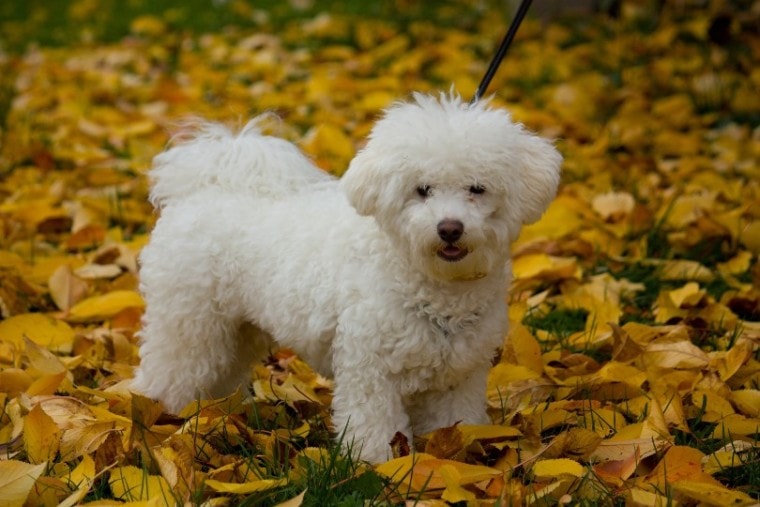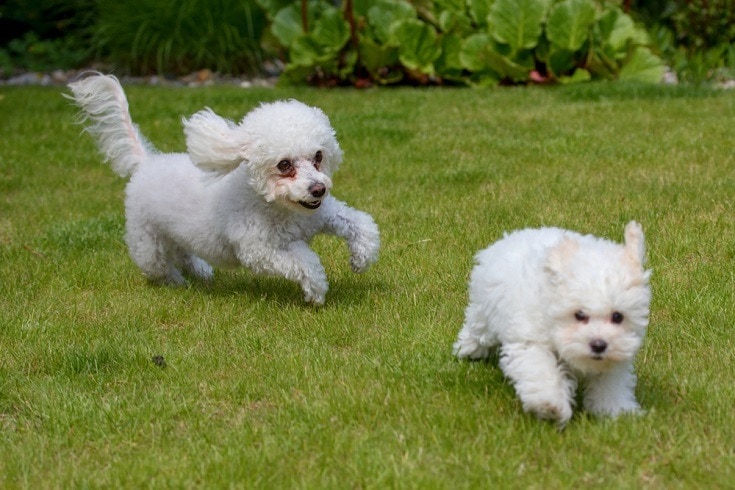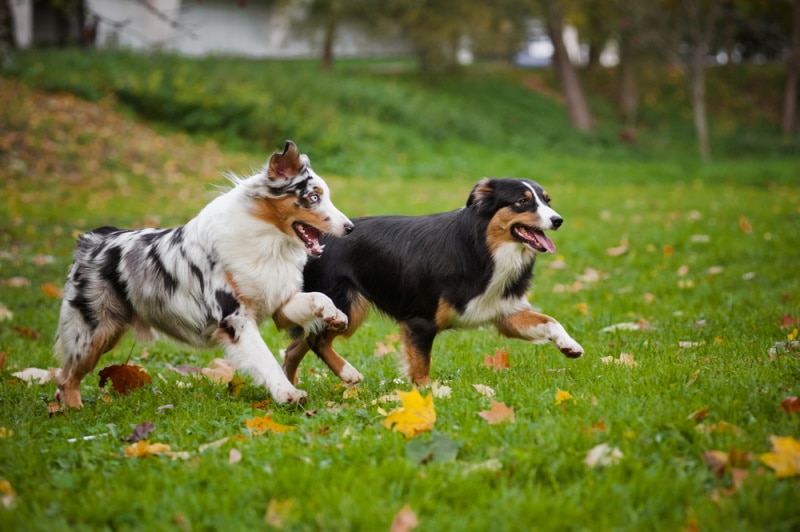
Click Below to Skip Ahead
The Bolognese breed is part of the AKC’s Foundation Stock Service, so they’re not an officially recognized breed yet. However, you almost certainly know of their popular cousin breeds, like the Bichon Frise, Maltese, or Havanese. Also called Bolo, the Bolognese is a bichon-type dog, and they’re often referred to as Bichon Bolognese.
Breed Overview
Height:
10 – 12 inches
Weight:
5 – 9 pounds
Lifespan:
12 – 14 years
Colors:
White
Suitable for:
Families and individuals that won’t be leaving their dog alone too much
Temperament:
Affectionate, demanding, aloof with strangers, hates to be left alone
These all-white dogs were always intended as companion pets and were long kept almost exclusively by nobles. The breed first started in the 11th century in Italy. Noble families would often gift these dogs between each other, and it appeared that the breed’s fate was tied to that of the nobility; the two nearly disappeared at the same time.
Centuries later, in the 1980s, restoration efforts on the breed were started by Gian Franco Gianneli. Today, the breed is enjoying much-renewed enthusiasm and popularity. They’re a relatively easy dog to care for and make great companion pets for anyone that doesn’t work a standard 40-hour week. These dogs need lots of engagement and attention. They hate being left alone and don’t do well in households where they’d be forced to spend a lot of time on their own.
Bolognese Characteristics
Bolognese Puppies
Though once incredibly rare, Bolognese dogs are much more prevalent today than in years past. They’re still not nearly as commonplace as other breeds in the same family, but if you decide to look for a Bolognese breeder, you shouldn’t have too much trouble locating one.
On average, Bolognese puppies cost about the same as other Bichon-type dogs, including the Bichon Frise or the Havanese. Granted, prices can vary quite a bit, but it is a good starting place for an average-quality Bolognese puppy intended to be kept as a companion pet.
Although the Bolognese breed is yet to receive official recognition from the AKC, they’re still used in international shows. Because of this, some specimens can go for extremely high prices.
If you are away from your home a lot, then think carefully before adopting a Bolognese as they won’t enjoy being alone for too long.
Temperament & Intelligence of the Bolognese
Naturally, Bolognese dogs are alert and shy. They’re a bit aloof naturally and tend to be wary of everyone. But these dogs also need tons of attention and can’t stand to be alone. If you leave your Bolognese alone too often, it will turn into a yappy, anxious dog that’s not a joy to be around. But Bolognese are also thought to be some of the smartest Bichon-type dogs around, so with a bit of socialization and training, your Bolognese will make a well-adapted member of the family.
Are These Dogs Good for Families? 👪
Bolognese dogs are exceptionally well suited for family life. This breed was always intended to be a companion breed, and they’re great at it. Bolognese dogs can sense your emotions and will always be by your side when you need them.
However, they also need outrageous amounts of attention. These dogs hate to be left alone and want to be with someone at all times. This makes them great family dogs since there’s more likely to be someone home most of the day. Unfortunately, Bolognese aren’t a great fit for couples or individuals who are gone at work every day. However, they are ideal dogs for apartment living, thanks to their small size and low to moderate exercise requirements.
Does This Breed Get Along with Other Dogs?
With proper socialization that starts at an early age and continues regularly as the dog grows, a Bolognese can get along well with other dogs. They don’t have a strong prey drive since they’ve always been companion pets, but their general wariness can make them very shy around other dogs if they’re not used to them.
Things to Know When Owning a Bolognese:
Food & Diet Requirements 🦴
Bolognese are rather tiny dogs, weighing under 10 pounds and standing less than a foot tall at the shoulders. As such, they don’t require too much food. You’ll do fine feeding a Bolognese high-quality dry kibble that’s specifically engineered for small breeds. Just be careful not to overfeed your Bolognese as small dogs are highly susceptible to obesity.
Because the Bolognese breed is vulnerable to hip dysplasia, it’s recommended that you ensure your dog gets glucosamine and chondroitin through its diet. Many high-quality commercial dog foods are fortified with these compounds, or you can supplement your dog’s diet with something like the PetNC Natural Care Hip & Joint Mobility Support Supplement to give your dog the best chance of fighting off hip dysplasia.
Exercise 🐕
Thanks to the small size of the Bolognese breed, they don’t require too much exercise. For this reason, they make great dogs for apartment dwellers. A short walk or play session once or twice a day should suffice. Your Bolognese won’t need more than 30 minutes of exercise each day to stay healthy and happy.
Training 🎾
Bolognese are considered the smartest of the Bichon-type breeds. Therefore, it makes sense that they’re one of the easiest to train. These are also dogs that love to please their owners, but things don’t add up the way you expect. Bichon breeds are notoriously difficult to housebreak, and the Bolognese is no exception. Still, basic obedience training tends to go over well with this breed. You’ll just need a ton of patience to housebreak your Bolognese.
Grooming ✂️
One look at the coat of a Bolognese might turn you off of the breed for fear of excessive grooming needs. Thankfully, it’s not as bad as it first appears. Despite the long coat, they need only moderate grooming. If you trim your dog’s coat regularly, then upkeep is very simple and brushing is only needed once or twice a week. For Bolognese with a long coat, daily brushing is required to prevent unpleasant odors and a matted, tangled coat. Aside from this basic coat upkeep, Bolognese need only nail trimming and regular dental care.
Though the Bolognese has long hair, they’re a very low-shedding dog. They’re even considered to be a hypoallergenic breed, so if you suffer from mild dog allergies, you might try your luck with a Bolognese.

Health and Conditions 🏥
All in all, Bolognese are considered to be pretty healthy dogs, like other Bichon-type dogs. Of course, they’re still susceptible to a few conditions, and the following health concerns are the conditions most likely to arise in a Bolognese.
Minor Conditions
Serious Conditions
Male vs Female
Male and female Bolognese bear few noticeable differences. They’re about the same size and weight with very similar features. Physically, it can be difficult to even tell them apart. But when it comes to their personalities, there are some distinct differences between them.
Females tend to be less friendly than males. They’re a bit more reserved and wary, and often, they’re quite shy around strangers. Females are less likely to be affectionate and loving, though it’s not unheard of. Males are generally much more affectionate and loving dogs. They prefer to spend their time playing and will cuddle up with just about anyone.
3 Little-Known Facts About the Bolognese
1. They’re Good at Reading Human Emotions
One reason for the immense popularity of the Bolognese breed as a companion pet is that they’re incredibly adept at reading human emotions. These are the types of dogs that always seem to know what you’re feeling. When you’re down, your Bolognese will sense it, almost like a sixth sense, and will be by your side to comfort you. It’s one of the greatest things about these types of dogs, and no doubt, it’s a major part of the reason they were popular thousands of years ago as well.
2. Bolognese Are Difficult Dogs to Housebreak
The Bichon family of dogs is notoriously difficult to housebreak. It’s not just the Bolognese; all the dogs in this family share this problem, including Maltese, Havanese, Bichon Frise, and Coton. It’s almost mandatory to crate train these dogs. Luckily, the Bolognese is often considered by breeders to be the smartest breed of the bunch. Hopefully, that translates to a slightly easier time housebreaking a Bolognese than other Bichon-type breeds.
3. They Require More Socialization Than Many Breeds
Without proper socialization, your Bolognese might become a very difficult dog to deal with. They’re naturally a bit skittish, but that can become more pronounced without socialization. Then, your Bolognese will always be fearful and aloof around people and other pets, which isn’t what you want.
Final Thoughts
If you’re looking for a companion dog that wants to spend every minute of the day with you, then the Bolognese breed might be a good fit. The hardest part of their upkeep is simply the amount of attention they need. Their exercise needs are minimal and even grooming a Bolognese doesn’t require too much investment of time, but because they’re prone to separation anxiety, these dogs are a poor fit for anyone who works full-time away from home. Still, for the individual or family that’s home most of every day, the Bolognese could be a great companion pet that’s in tune with your emotions and always there when you need it.
See also:
Featured Image Credit: islavicek, Shutterstock









